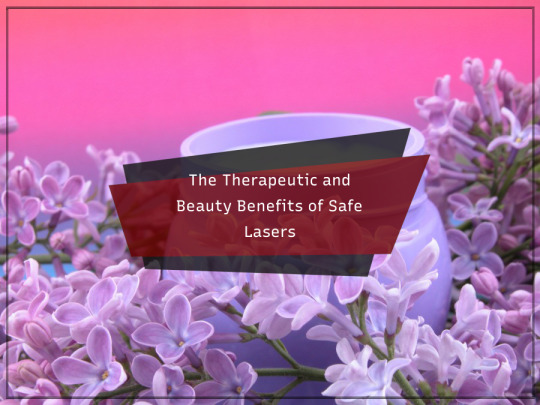Text
The Therapeutic and Beauty Benefits of Safe Lasers

lágylézer s, also known as safe lasers, have gained immense popularity in recent years due to their numerous therapeutic effects and beauty benefits. These low-power lasers emit light at specific wavelengths, which can interact with the body's cells and tissues, promoting healing and rejuvenation. This article will delve into the various therapeutic effects of safe lasers and how they can enhance your beauty.
Therapeutic Effects of Safe Lasers:
1. Pain Relief:
Safe lasers emit low levels of red and near-infrared light, which can penetrate deep into the skin and muscles, reducing inflammation and relieving pain. They are commonly used to treat conditions such as arthritis, muscle spasms, and fibromyalgia.
2. Wound Healing:
The red light emitted by safe lasers stimulates the production of collagen and elastin, two proteins essential for skin elasticity and wound healing. This makes them an effective treatment for burns, scars, and other skin injuries.
3. Anti-Aging:
By promoting collagen production and reducing inflammation, safe lasers can help reduce the appearance of fine lines and wrinkles. They also stimulate the growth of new skin cells, giving the skin a youthful, glowing appearance.
4. Hair Growth:
Low-level laser therapy (LLLT) has been shown to increase hair growth in both men and women. The lasers stimulate hair follicles, encouraging them to enter an active growth phase and promoting thicker, fuller hair.
5. Dental Health:
Safe lasers are used in dentistry to treat gum disease, tooth decay, and oral infections. The lasers kill bacteria and remove infected tissue without damaging surrounding healthy tissue, resulting in faster healing and improved dental health.
Beauty Benefits of Safe Lasers:
1. Acne Treatment:
Safe lasers can effectively treat acne by killing the bacteria that cause the infection and reducing inflammation. They also help to unclog pores and stimulate the growth of healthy skin cells, resulting in clearer, smoother skin.
2. Skin Rejuvenation:
The red and near-infrared light emitted by safe lasers can penetrate deep into the skin, promoting collagen production and improving skin elasticity. This makes them an ideal treatment for conditions such as rosacea, age spots, and uneven skin tone.
3. Cellulite Reduction:
Safe lasers can break down the fat cells responsible for cellulite, resulting in smoother, toned skin. The lasers also stimulate lymphatic drainage, helping to reduce swelling and fluid retention.
4. Nail Fungus Treatment:
Low-level laser therapy has been shown to effectively treat nail fungus by killing the fungi that cause the infection. This non-invasive treatment is safer and more comfortable than traditional surgical methods.
Conclusion:
Safe lasers offer a plethora of therapeutic effects and beauty benefits, making them a popular choice for those seeking natural, non-invasive treatments. From pain relief and wound healing to hair growth and acne treatment, the applications of soft lasers are vast and continue to grow. As more research is conducted, it's evident that safe lasers hold great potential in the fields of medicine and beauty.
0 notes
Text
The Therapeutic Effects and Beauty Benefits of Safe Lasers

In recent years, the use of lasers in the field of medicine and aesthetics has gained popularity due to their effectiveness and precision. One such type of laser is the lágylézer , which offers a range of therapeutic effects and beauty benefits. This article will explore the various applications of soft lasers in dermatology, dentistry, and other fields, as well as the safety and efficacy of these treatments.
Therapeutic Effects of Soft Lasers:
Soft lasers, also known as low-level laser therapy (LLLT), emit low-energy, non-thermal photons that can penetrate tissues without causing damage. These lasers have been found to have numerous therapeutic effects, including:
1. Anti-inflammatory properties: Soft lasers can help reduce inflammation and swelling in various conditions, such as arthritis, gum disease, and acne.
2. Pain relief: Low-level laser therapy has been shown to alleviate pain associated with conditions like fibromyalgia, migraine headaches, and dental procedures.
3. Tissue regeneration: Soft lasers can stimulate the production of collagen and other growth factors, promoting faster wound healing and tissue repair.
4. Improved blood circulation: By increasing the production of nitric oxide, soft lasers can enhance blood flow, delivering oxygen and nutrients to cells and tissues.
Beauty Benefits of Soft Lasers:
The beauty industry has also embraced the use of soft lasers for their ability to provide effective and non-invasive treatments. Some of the key beauty benefits include:
1. Hair removal: Soft lasers can be used for permanent hair reduction by targeting melanin in the hair follicles, reducing the need for painful waxing or shaving.
2. Skin rejuvenation: By promoting collagen production and increasing blood flow, soft lasers can improve skin texture, reduce the appearance of fine lines and wrinkles, and treat acne scars.
3. Stretch mark treatment: Soft laser therapy can stimulate the production of collagen and elastin, helping to reduce the appearance of stretch marks and promote skin elasticity.
4. Nail fungus treatment: Low-level laser therapy has been found to be an effective treatment for onychomycosis, a fungal infection of the nails.
Safety of Soft Lasers:
Unlike high-energy lasers, soft lasers emit low levels of energy that do not cause tissue damage or burns. However, it is essential to ensure that the laser is used by a qualified professional who can assess the patient's condition and adjust the settings accordingly. Some potential side effects may include temporary skin redness or sensitivity, but these are typically mild and short-lived.
Conclusion:
Soft lasers have proven to be a versatile and safe treatment option for various therapeutic and beauty applications. As technology continues to advance, the use of low-level laser therapy is likely to become even more widespread, offering patients effective, non-invasive alternatives to traditional treatments.
1 note
·
View note